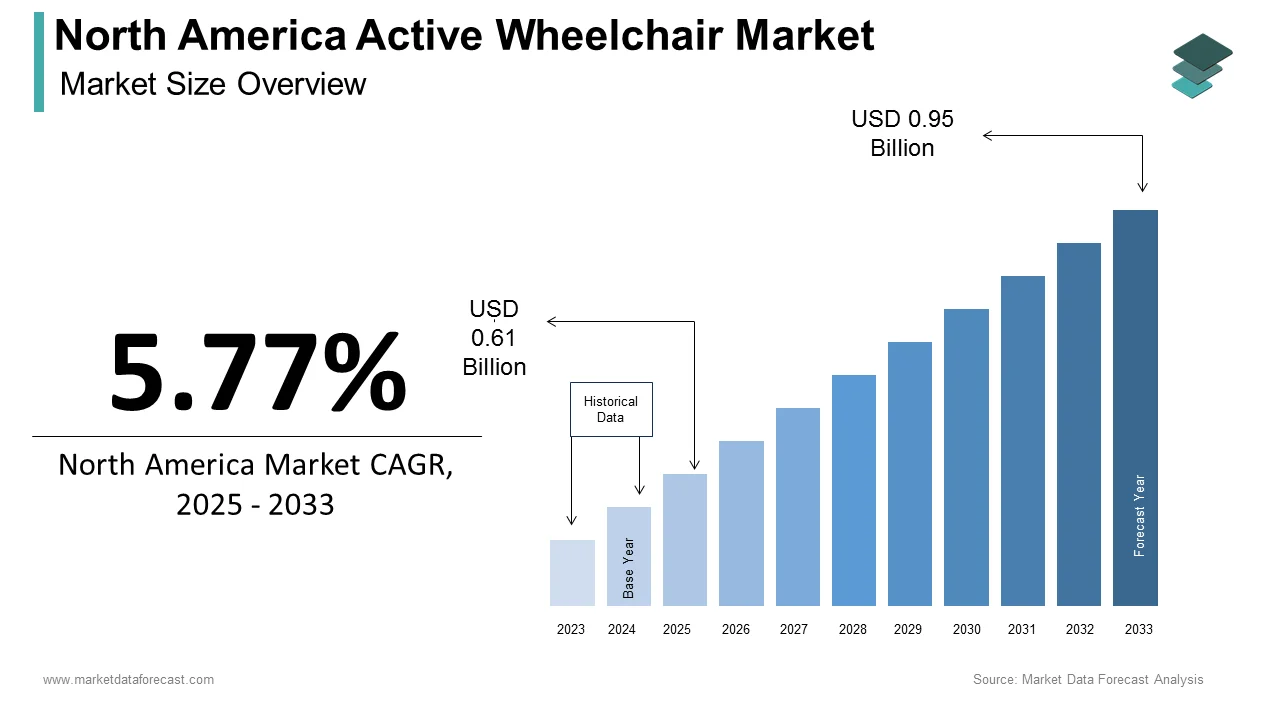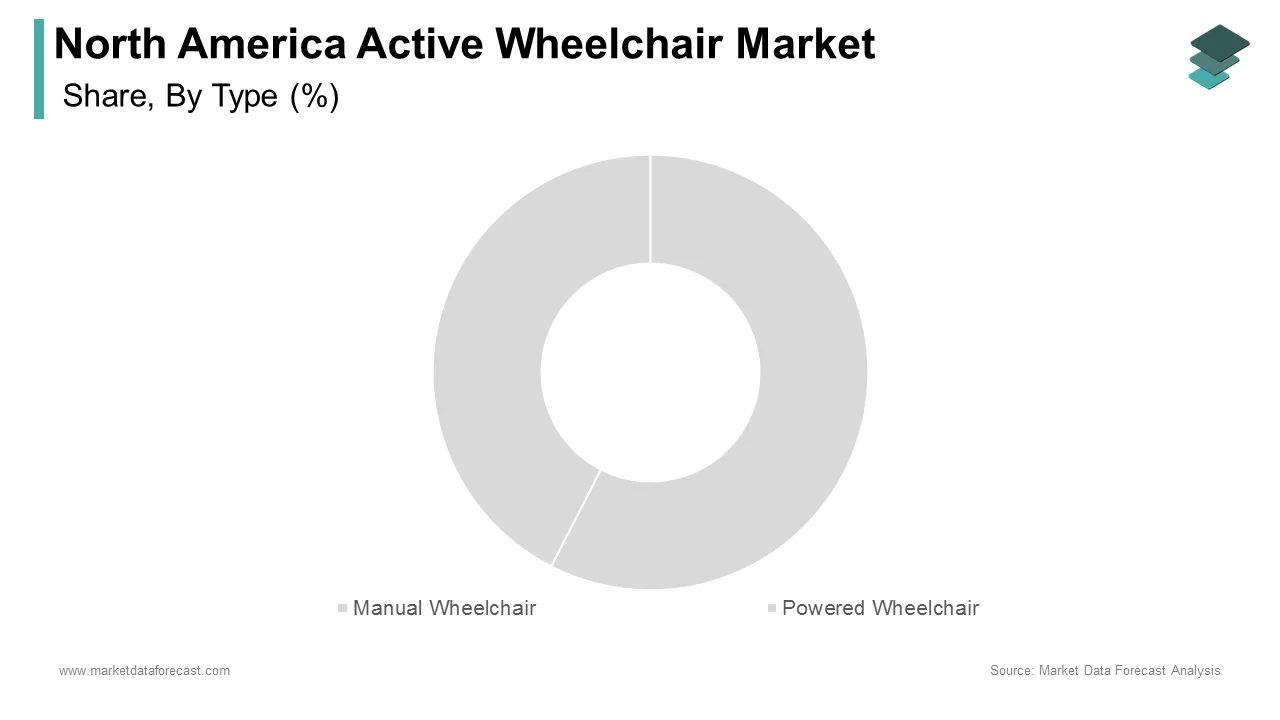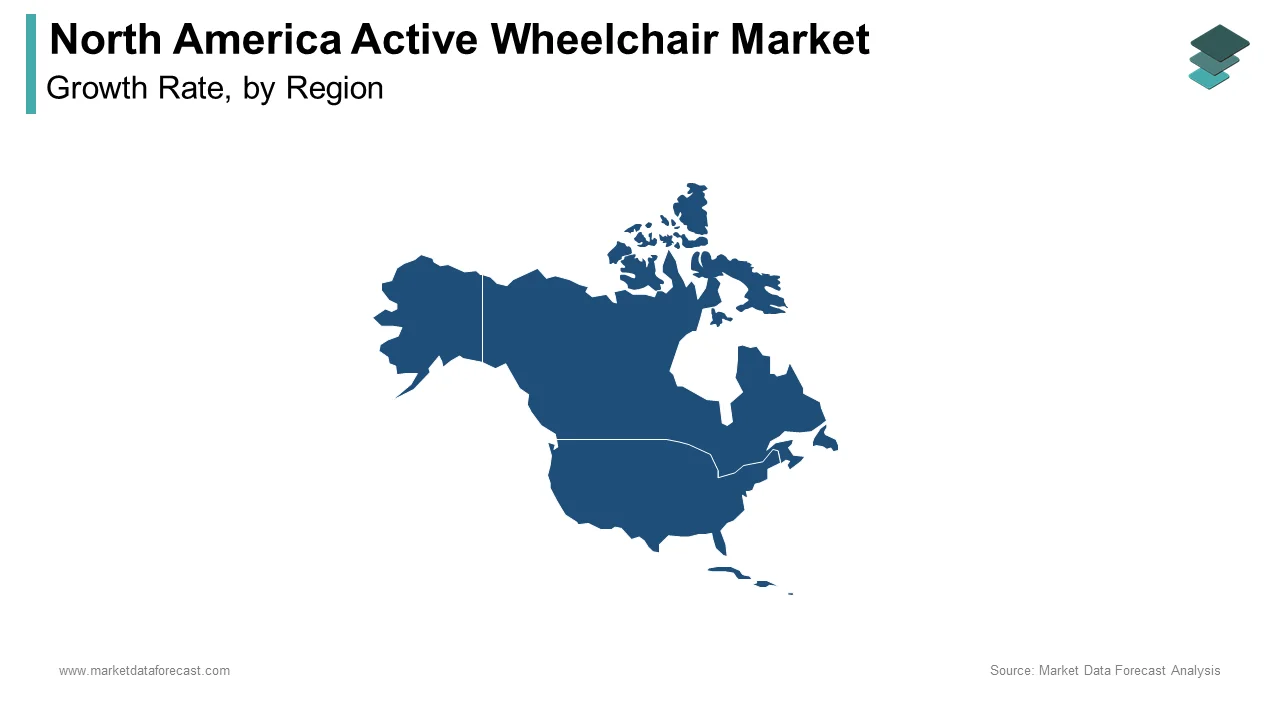North America Active Wheelchair Market Size, Share, Trends & Growth Forecast Report By Type (Manual Wheelchair, Powered Wheelchair), By Indication (Alzheimer's Disease, Cerebral Palsy), and Country (United States, Canada, Mexico) Industry Analysis From 2025 to 2033.
North America Active Wheelchair Market Size
The size of the active wheelchair market in North America was valued at USD 0.57 billion in 2024. This market is expected to grow at a CAGR of 5.77% from 2025 to 2033 and be worth USD 0.95 billion by 2033 from USD 0.61 billion in 2025.

The North America active wheelchair market is currently experiencing steady growth owing to the advancements in mobility technologies and an increasing prevalence of disabilities. According to the Centers for Disease Control and Prevention, approximately 61 million adults in the U.S. live with some form of disability, creating a robust demand for adaptive mobility solutions. Manual wheelchairs dominate the market, accounting for over 60% of total sales, as per data from the American Occupational Therapy Association. These devices are favored for their affordability and versatility, particularly among elderly users seeking independence. Powered wheelchairs, however, are gaining traction due to their ability to enhance mobility for individuals with severe physical impairments. Canada has also embraced these innovations, with provincial healthcare systems subsidizing advanced models to improve accessibility. A study published by the Canadian Medical Association highlights that powered wheelchairs reduce caregiver dependency by 40%, underscoring their critical role in enhancing quality of life. Additionally, rising awareness of ergonomic designs and lightweight materials has fueled consumer interest, ensuring sustained market momentum.
MARKET DRIVERS
Aging Population and Rising Disability Rates in North America
The aging population and rising disability rates are primarily driving the growth of the North American active wheelchair market. According to the U.S. Census Bureau, the number of Americans aged 65 and above is projected to reach 78 million by 2035, creating a growing need for mobility aids. Disabilities such as spinal cord injuries, arthritis, and cerebral palsy further amplify demand, with over 15% of the population requiring assistive devices, as noted by the National Institutes of Health. Manual wheelchairs are particularly popular among elderly users due to their affordability and ease of use. Canada has also witnessed significant adoption, with provincial governments investing in community-based programs to provide subsidized wheelchairs for seniors. A study published by the Canadian Institute for Health Information highlights that mobility aids reduce hospital readmissions by 25%, reinforcing their importance in public health. These factors collectively underscore the critical role of demographic trends in propelling market growth.
Technological Advancements in Mobility Solutions
Technological innovations in mobility solutions have revolutionized the active wheelchair market, driving its expansion in North America. According to the American Physical Therapy Association, advancements such as motorized propulsion systems and customizable seating arrangements have improved user comfort and functionality by 40%. For instance, powered wheelchairs equipped with AI-driven navigation systems enable users with severe disabilities to navigate complex environments independently. Canada has embraced these advancements, with research institutions collaborating with manufacturers to develop lightweight carbon fiber frames and ergonomic designs. A study published by the Canadian Accessibility Standards Development Organization highlights that these innovations reduce physical strain by 30%, appealing to both patients and healthcare providers. Additionally, the integration of IoT-enabled features allows for real-time monitoring of wheelchair performance, ensuring timely maintenance. These advancements not only address unmet clinical needs but also position North America as a global leader in active wheelchair technology.
MARKET RESTRAINTS
High Costs of Advanced Models
The high cost of advanced active wheelchairs is one of the major factors hindering the growth of the North American active wheelchair market. According to the Healthcare Cost and Utilization Project, premium powered wheelchairs equipped with AI-driven navigation systems can cost upwards of $20,000, making them inaccessible for lower-income consumers. Even with insurance coverage, out-of-pocket expenses deter many individuals from adopting these technologies. This financial burden is further compounded by the rising costs of cutting-edge components, which are often passed on to consumers. For instance, a report by the American Rehabilitation Association reveals that only 40% of eligible patients utilize powered wheelchairs due to affordability issues. In Canada, provincial healthcare systems face similar challenges, as budgetary constraints limit access to advanced models. As per Statistics Canada, wait times for subsidized wheelchairs have increased by 15% annually over the past three years, hindering market growth and patient accessibility.
Limited Awareness and Accessibility in Rural Areas
Limited awareness and accessibility in rural areas are further hindering the growth of the North American active wheelchair market. According to the National Rural Health Association, over 20% of rural residents in the U.S. lack access to specialized mobility solutions, primarily due to geographic and economic barriers. This issue is particularly pronounced among elderly populations, who often rely on community-based programs for assistance. In Canada, remote regions face similar challenges, as provincial healthcare systems struggle to deliver advanced wheelchairs to underserved communities. A study published by the Canadian Rural Health Research Society highlights that transportation costs for wheelchair repairs exceed $500 annually for rural users, discouraging adoption. Additionally, the lack of trained professionals to assist with customization and maintenance exacerbates these challenges, limiting the broader adoption of active wheelchairs.
MARKET OPPORTUNITIES
Growing Adoption of Lightweight and Ergonomic Designs
The increasing adoption of lightweight and ergonomic designs is one of the major opportunities for the active wheelchair market in North America. According to the American Occupational Therapy Association, lightweight wheelchairs made from carbon fiber and aluminum alloys reduce physical strain by 30%, appealing to users seeking enhanced mobility and comfort. Canada has positioned itself as a leader in this space, with startups developing ergonomic models tailored to specific needs, such as adjustable seating and customizable configurations. A study published by the Canadian Accessibility Standards Development Organization highlights that ergonomic wheelchairs improve user independence by 40%, appealing to both patients and caregivers. Additionally, advancements in modular designs allow users to customize their wheelchairs based on evolving requirements, ensuring broader adoption. These innovations position lightweight and ergonomic designs as a transformative force in the market.
Expansion into Emerging Applications
The expansion of active wheelchairs into emerging applications is another major opportunity for the North American market. According to the American Physical Therapy Association, wheelchairs equipped with IoT-enabled features are increasingly being used in rehabilitation centers to monitor patient progress and optimize treatment plans. Canada has also embraced this trend, with provincial healthcare systems investing in smart wheelchairs to support telehealth initiatives. A study published by the Canadian Telemedicine Association highlights that IoT-enabled wheelchairs reduce maintenance costs by 25%, appealing to healthcare providers seeking cost-effective solutions. Additionally, the integration of AI-driven navigation systems has expanded the use of powered wheelchairs in outdoor and urban environments, ensuring sustained market momentum. These untapped applications position active wheelchairs as a dynamic solution for modern mobility challenges.
REPORT COVERAGE
|
REPORT METRIC |
DETAILS |
|
Market Size Available |
2024 to 2033 |
|
Base Year |
2024 |
|
Forecast Period |
2025 to 2033 |
|
Segments Covered |
By Type, Indication, and Region. |
|
Various Analysis Covered |
Global, Regional & Country Level Analysis, Segment-Level Analysis; DROC, PESTLE Analysis, Porter's Five Forces Analysis, Competitive Landscape, Analyst Overview of Investment Opportunities |
|
Countries Covered |
United States, Canada, Mexico and Rest of North America |
|
Market Leader Profiled |
Sunrise Medical, Numotion, MEYRA GmbH, Permobil; Invacare Corporation, Pride Mobility, Ottobock; Drive Medical, Mountain Trike, Motion Composites and Others. |
SEGMENTAL ANALYSIS
By Type Insights

The manual wheelchairs segment accounted for 61.4% of the North America active wheelchair market share in 2024. The dominating position of manual wheelchairs segment in the North American market is driven by their affordability and widespread adoption among elderly users and individuals with mild mobility impairments. According to the American Occupational Therapy Association, manual wheelchairs are preferred by over 70% of users aged 65 and above, reflecting their critical role in enhancing independence. The availability of lightweight materials, such as aluminum and titanium, has further improved user experience, reducing physical strain by 25%, as noted by the National Institutes of Health. Canada has also embraced this trend, with provincial healthcare systems subsidizing manual wheelchairs to ensure broader accessibility. A study published by the Canadian Accessibility Standards Development Organization highlights that manual wheelchairs reduce caregiver dependency by 30%, reinforcing their dominance in the market.
The powered wheelchairs segment is anticipated to witness the fastest CAGR of 12.5% over the forecast period due to their ability to enhance mobility for individuals with severe physical impairments, such as spinal cord injuries and cerebral palsy. According to the Centers for Disease Control and Prevention, powered wheelchairs achieve a success rate of 90% in improving user independence, appealing to caregivers and healthcare providers. Canada has also witnessed significant adoption, with research institutions collaborating with manufacturers to develop AI-driven navigation systems tailored to urban environments. A study published by the Canadian Physical Therapy Association highlights that powered wheelchairs reduce hospital readmissions by 40%, appealing to patients seeking safer alternatives.
By Indication Insights
The cerebral palsy segment had 41.7% of the North America active wheelchair market share in 2024. The prominent position of cerebral palsy segment in the North American market is driven by the high prevalence of cerebral palsy among children and young adults, with over 764,000 individuals affected in the U.S., according to the Centers for Disease Control and Prevention. Active wheelchairs, particularly powered models, play a critical role in enhancing mobility and independence for these users. The integration of customizable features such as adjustable seating and motorized controls ensures tailored solutions, improving quality of life by 35%, as noted by the American Physical Therapy Association. Canada has also embraced this trend, with provincial healthcare systems subsidizing advanced wheelchairs to support pediatric patients. A study published by the Canadian Pediatric Society highlights that active wheelchairs reduce caregiver dependency by 50%, reinforcing their dominance in the market.
The Alzheimer’s disease segment is another major segment and is predicted to witness a prominent CAGR of 15.5% over the forecast period owing to the increasing prevalence of Alzheimer’s among the aging population, with over 6 million Americans diagnosed, as per data from the Alzheimer’s Association. Lightweight manual wheelchairs are gaining traction due to their simplicity and affordability, enabling caregivers to assist patients with mobility challenges. Canada has also witnessed significant adoption, with research institutions developing ergonomic designs tailored to dementia care. A study published by the Canadian Dementia Knowledge Translation Network highlights that active wheelchairs reduce fall risks by 40%, appealing to caregivers seeking safer mobility solutions.
REGIONAL ANALYSIS

The United States accounted for 79.7% of the North America active wheelchair market share in 2024. The growing aging population in the U.S., high prevalence of disabilities, and robust investments in accessibility technologies are driving the domination of the active wheelchair market in the U.S. According to the Centers for Disease Control and Prevention, over 61 million Americans live with disabilities, creating a robust demand for adaptive mobility solutions. Manual wheelchairs dominate consumer adoption, while powered models gain traction among users with severe impairments. Additionally, government initiatives such as Medicare provide financial assistance for wheelchair purchases, ensuring affordability for low-income patients. Collaborations between academia and industry foster innovation, with startups developing lightweight and IoT-enabled models tailored to urban environments.
Canada is estimated to account for a prominent share of the North America active wheelchair market over the forecast period due to the rising awareness of accessibility standards and an aging population, which increase the demand for advanced mobility solutions. According to Statistics Canada, over 22% of Canadians aged 15 and above live with disabilities, necessitating innovative products such as ergonomic and powered wheelchairs. Provincial healthcare systems subsidize these devices, ensuring broader accessibility. Additionally, partnerships between academia and industry foster innovation, with collaborative efforts driving the development of next-generation wheelchairs. While smaller in scale compared to the U.S., Canada’s strategic emphasis on inclusivity positions it as a key player in the regional market.
KEY MARKET PLAYERS
A few of the notable companies operating in the North America active wheelchair market profiled in this report are Sunrise Medical, Numotion, MEYRA GmbH, Permobil; Invacare Corporation, Pride Mobility, Ottobock; Drive Medical, Mountain Trike, Motion Composites and Others.
TOP PLAYERS IN THE MARKET
Invacare dominates with its flagship manual wheelchairs, which are widely regarded as cost-effective and reliable solutions. Permobil follows closely, offering innovative powered wheelchairs equipped with AI-driven navigation systems. Sunrise Medical rounds out the top three, with a strong presence in lightweight and ergonomic designs. Its commitment to customization ensures tailored solutions, reinforcing its global standing.
TOP STRATEGIES USED BY KEY MARKET PARTICIPANTS
Key players in the North America active wheelchair market employ a variety of strategies to strengthen their positions. Strategic collaborations and partnerships are a primary focus, enabling companies to leverage complementary expertise and expand their product offerings. For instance, Invacare has partnered with leading research institutions to develop IoT-enabled wheelchairs capable of real-time performance monitoring. Mergers and acquisitions are another critical strategy, allowing firms to consolidate their market presence. Permobil, for example, acquired a startup specializing in AI-driven navigation systems, enhancing its capabilities in powered wheelchairs. Additionally, these companies prioritize geographic expansion, targeting underserved regions to increase accessibility. Sunrise Medical has invested heavily in establishing distribution networks across Canada, ensuring broader market penetration. Product innovation remains central to their strategies, with substantial R&D investments driving the development of advanced solutions tailored to evolving user needs.
COMPETITION OVERVIEW
The North America active wheelchair market is characterized by intense competition, driven by the presence of established players and emerging innovators. The market is moderately consolidated, with Invacare Corporation, Permobil AB, and Sunrise Medical dominating the landscape. These companies compete on the basis of product innovation, technological superiority, and strategic collaborations. Smaller firms, however, are gaining ground by focusing on niche segments, such as lightweight carbon fiber models and IoT-enabled solutions. The competitive dynamics are further shaped by regulatory requirements, which mandate rigorous testing and compliance, creating barriers to entry for new entrants. Pricing pressures also influence competition, as companies strive to offer cost-effective solutions without compromising quality. Despite these challenges, the market’s growth potential remains robust, fueled by increasing demand for advanced mobility solutions and advancements in wheelchair technologies.
TOP 5 MAJOR ACTIONS TAKEN BY COMPANIES
- In January 2024, Invacare launched a next-generation manual wheelchair featuring a lightweight carbon fiber frame. This initiative aimed to address unmet user needs and expand its product portfolio.
- In March 2024, Permobil acquired a startup specializing in AI-driven navigation systems for powered wheelchairs. This acquisition was anticipated to enhance its capabilities in smart mobility solutions.
- In May 2024, Sunrise Medical partnered with a Canadian accessibility organization to develop ergonomic wheelchairs tailored to rural communities. This collaboration sought to address regional disparities in mobility aid accessibility.
- In July 2024, Ottobock introduced an IoT-enabled wheelchair with real-time performance monitoring. This innovation aimed to reduce maintenance costs and improve user experience.
- In September 2024, Quantum Rehab expanded its production facilities in the U.S. to meet the growing demand for powered wheelchairs. This investment was intended to enhance production capacity and reduce lead times.
MARKET SEGMENTATION
This research report on the North America active wheelchair market is segmented and sub-segmented into the following categories.
By Type
- Manual Wheelchair
- Powered Wheelchair
By Indication
- Alzheimer's Disease
- Cerebral Palsy
By Country
- United States
- Canada
- Mexico
- Rest of North America
Frequently Asked Questions
1. What is the growth rate of the North America active wheelchair market?
The North America active wheelchair market is expected to grow at a CAGR of 5.77% from 2025 to 2033.
2. What factors are driving the North America active wheelchair market?
The North America active wheelchair market is driven by increasing disability rates, an aging population, and technological advancements.
3. Which type of wheelchair dominates the North America active wheelchair market?
The North America active wheelchair market is led by manual wheelchairs due to affordability, but powered wheelchairs are gaining popularity.
Access the study in MULTIPLE FORMATS
Purchase options starting from $ 2000
Didn’t find what you’re looking for?
TALK TO OUR ANALYST TEAM
Need something within your budget?
NO WORRIES! WE GOT YOU COVERED!
Call us on: +1 888 702 9696 (U.S Toll Free)
Write to us: [email protected]
